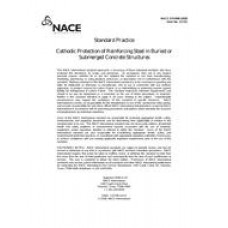NACE SP0408-2008
- Cathodic Protection of Reinforcing Steel in Buried or Submerged Concrete Structures
- standard by National Association of Corrosion Engineers, 11/07/2
- Category: NACE
$169.00
$85.00
1.1.1 Reinforcing steel is compatible with concretebecause of similar coefficients of thermal expansionand because concrete normally provides the steel withexcellent corrosion protection. The corrosion protectionis the result of the formation of a passive oxide film onthe surface of the reinforcing steel by highly alkalineportland cement contained in the concrete. Thispassive oxide film can be compromised by (1)excessive amounts of chloride or other corrosive ionsand gases, or (2) the steel not being sufficientlyencased by the concrete.
1.1.2 Corrosion occurs as a result of the formation ofan electrochemical cell. An electrochemical cellconsists of four components: an anode, whereoxidation occurs; a cathode, where reduction occurs; ametallic path, where electrons flow; and an electrolyte(concrete), where ions flow. The anodic and cathodicareas occur as a result of coupling dissimilar metals,exposure to different environmental conditions, or both.If any one of the four elements of the electrochemicalcell is eliminated, corrosion can be prevented.
1.2 Cathodic Protection
1.2.1 The basic principles of corrosion can be used tounderstand the theory of CP. CP reduces thecorrosion of a metal surface by making the protectedsurface the cathode of an electrochemical cell.
1.2.2 CP is a proven technique for controllingcorrosion of steel in chloride-contaminated concretestructures. However, CP neither replaces lost steel norreturns corroded reinforcing steel to its original crosssection.
1.2.3 CP of reinforcing steel in atmosphericallyexposed concrete is described in NACE SP0290.Many of the practices described in that document arerelevant to buried and submerged elements. Otheranode types are also applicable to buried andsubmerged elements, as the soil or water provides asomewhat homogenous medium for the anode system,which need not be fixed directly to the concrete. Theapplication of CP to prestressed concrete cylinderpipelines is described in NACE SP0100.
1.3 Scope and Limitations
1.3.1 The provisions of this standard should be appliedunder the direction of a registered ProfessionalEngineer or a person certified by NACE Internationalas a Corrosion Specialist or a CP Specialist. Theperson's professional experience should includesuitable experience in CP of reinforced concretestructures. Under certain circumstances, a CP systemmay either become a structural component orsignificantly affect the serviceability and structuralperformance of a reinforced concrete structure;therefore, such impact by the CP system should bereviewed by a qualified registered Structural Engineeror the equivalent.
1.3.2 The guidelines presented here are limited to CPsystems for new or existing buried or submergedreinforced concrete elements.
1.3.3 When the reinforcing steel is bonded to facilitygrounding, as commonly required by the NationalElectrical Code,6 the resulting galvanic corrosion celland the possible adverse affects on the quantity anddistribution of CP current to the reinforcing steel shallbe considered.
 PDF
PDF
All of our standards document are available in PDF (Portable Document Format), an electronic, downloadable format.You will be able to download the file in your account downloads.
 Multi-User Access
Multi-User Access
After purchasing, you have the ability to assign each license to a specific user.
 Printable
Printable
At any time, you are permitted to make printed copies for your and your members' reference use.



